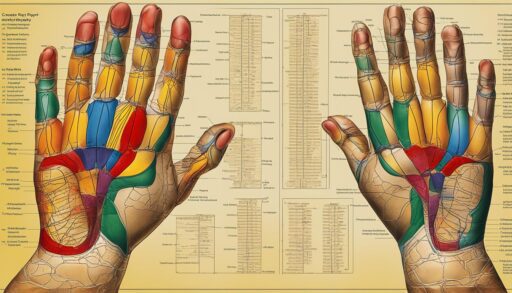Hand Reflexology

For centuries, various cultures have recognized the therapeutic benefits of reflexology, an ancient healing practice that stimulates specific pressure points to promote overall well-being. While foot reflexology is well-known, lesser-explored areas like the hands, face, and ears offer unique avenues for holistic healing. In this comprehensive guide, we will delve into the world of hand reflexology, exploring its techniques, benefits, and how it harmoniously coexists with facial and ear reflexology.
I. The Art of Hand Reflexology
Origins and Historical Significance
Hand reflexology, an ancient ealing art, traces its roots back to traditional Chinese medicine and the practices of ancient Egypt. With a rich history of promoting balance and vitality, hand reflexology focuses on specific points on the hands that correspond to various organs and systems in the body.
Principles and Techniques
Similar to foot reflexology, the hands are believed to have reflex points connected to different parts of the body. Practitioners apply specific thumb and finger techniques to stimulate these points, promoting energy flow and encouraging the body’s natural healing processes. Hand reflexology is a portable and accessible alternative to foot reflexology, making it a convenient self-care practice.
II. Unveiling the Benefits of Hand Reflexology
Stress Reduction and Relaxation
One of the primary benefits of hand reflexology is its ability to induce deep relaxation and alleviate stress. By targeting reflex points associated with the nervous system, practitioners can help individuals release tension and promote a sense of calm and balance.
Pain Management
Hand reflexology has been recognized for its effectiveness in managing pain and discomfort. By stimulating specific points on the hands, practitioners aim to reduce pain signals, improve circulation, and enhance the body’s natural pain-relieving mechanisms.
Improved Circulation
The practice of hand reflexology is known to enhance blood circulation throughout the body. This improved blood flow not only supports overall cardiovascular health but also aids in the delivery of oxygen and nutrients to various organs and tissues.
III. Facial Reflexology: Nurturing Radiant Wellness
Introduction to Facial Reflexology
Facial reflexology is a lesser-known but equally potent form of reflexology. This technique involves stimulating reflex points on the face to address various health concerns and promote balance. The face is rich in nerve endings, and facial reflexology harnesses this connection to influence the entire body.
Techniques and Reflex Points
Practitioners of facial reflexology employ gentle pressure, massage, and acupressure on specific zones of the face. These zones correspond to different organs and systems, making facial reflexology a comprehensive approach to holistic well-being. Techniques may include using fingers, thumbs, or specialized tools to stimulate reflex points.
IV. Facial Reflexology Benefits: A Holistic Approach to Wellness
Enhanced Skin Health
Beyond its therapeutic benefits, facial reflexology contributes to improved skin health. The stimulation of reflex points encourages better circulation, leading to a natural glow and increased vitality. Facial reflexology is increasingly recognized as a non-invasive and rejuvenating option for promoting skin health.
Stress Relief and Facial Muscle Relaxation
Similar to hand reflexology, facial reflexology promotes stress relief by targeting reflex points related to the nervous system. Additionally, the technique involves gentle manipulation of facial muscles, contributing to overall relaxation and a reduction in tension-related symptoms.
V. Ear Reflexology: A Gateway to Balance
Overview of Ear Reflexology
Ear reflexology, often referred to as auricular therapy, is a holistic practice that involves stimulating specific points on the ear to promote physical, mental, and emotional well-being. The ear is considered a microcosm of the entire body, with reflex points corresponding to various organs and systems.
Techniques and Reflex Points
Ear reflexology employs techniques such as gentle massage, acupressure, and the application of ear seeds or magnets to stimulate reflex points. Practitioners work on the external ear, targeting specific zones that correspond to different areas of the body.
VI. Ear Reflexology Benefits: Harmonizing Mind and Body
Stress Reduction and Mental Clarity
Ear reflexology is renowned for its ability to reduce stress, anxiety, and promote mental clarity. By stimulating reflex points associated with the brain and nervous system, practitioners help individuals achieve a sense of balance and tranquility.
Support for Various Health Conditions
Advocates of ear reflexology suggest that the practice may offer support for various health conditions, including pain management, insomnia, and digestive issues. While research in this area is ongoing, anecdotal evidence highlights the potential of ear reflexology as a complementary therapy.
VII. Integrating Hand, Facial, and Ear Reflexology: A Holistic Approach
Complementary Practices
While each form of reflexology – hand, facial, and ear – has its unique characteristics, they share a common foundation in the principles of energy flow and holistic healing. Integrating these practices allows individuals to create a comprehensive reflexology routine that addresses the diverse needs of the body, mind, and spirit.
Self-Care Strategies
Empowering individuals to incorporate hand, facial, and ear reflexology into their daily lives, this holistic approach to self-care encourages a deeper connection with the body’s innate healing abilities. With simple techniques that can be practiced anywhere, individuals can take an active role in maintaining their well-being.
VIII. Conclusion: Nurturing Wellness Through Reflexology
In conclusion, the world of reflexology extends beyond traditional foot treatments to encompass the hands, face, and ears. Hand reflexology offers a portable and accessible way to promote relaxation and balance, while facial and ear reflexology provides unique pathways to holistic wellness. By exploring these complementary practices, individuals can unlock the potential for self-healing, stress reduction, and overall vitality. As the ancient art of reflexology continues to evolve, embracing the diversity of techniques ensures that individuals can tailor their approach to suit their individual needs, fostering a harmonious connection between the body, mind, and spirit.
